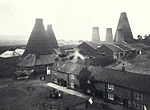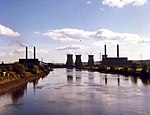Walbottle

Walbottle is a village in Tyne and Wear. It is a western suburb of Newcastle upon Tyne. The village name, recorded in 1176 as "Walbotl", is derived from the Old English botl (building) on Hadrian's Wall. There are a number of Northumbrian villages which are suffixed "-bottle". Bede, in his Ecclesiastical History of the English People, refers to a royal estate called Ad Murum near the Roman Wall where, in 653 AD, the King of the Middle Angles, Peada, and the King of the East Saxons, Sigeberht, were both baptised as Christians by Bishop Finan, having been persuaded to do so by King Oswy of Northumbria. Historians have identified Ad Murum as a possible reference to Walbottle.Ann Potter, the mother of Lord Armstrong, the famous industrialist, was born at Walbottle Hall in 1780 and lived there until 1801.
Excerpt from the Wikipedia article Walbottle (License: CC BY-SA 3.0, Authors, Images).Walbottle
A69, Newcastle upon Tyne Lemington
Geographical coordinates (GPS) Address Nearby Places Show on map
Geographical coordinates (GPS)
| Latitude | Longitude |
|---|---|
| N 54.993 ° | E -1.728 ° |
Address
A69
NE15 9SN Newcastle upon Tyne, Lemington
England, United Kingdom
Open on Google Maps








